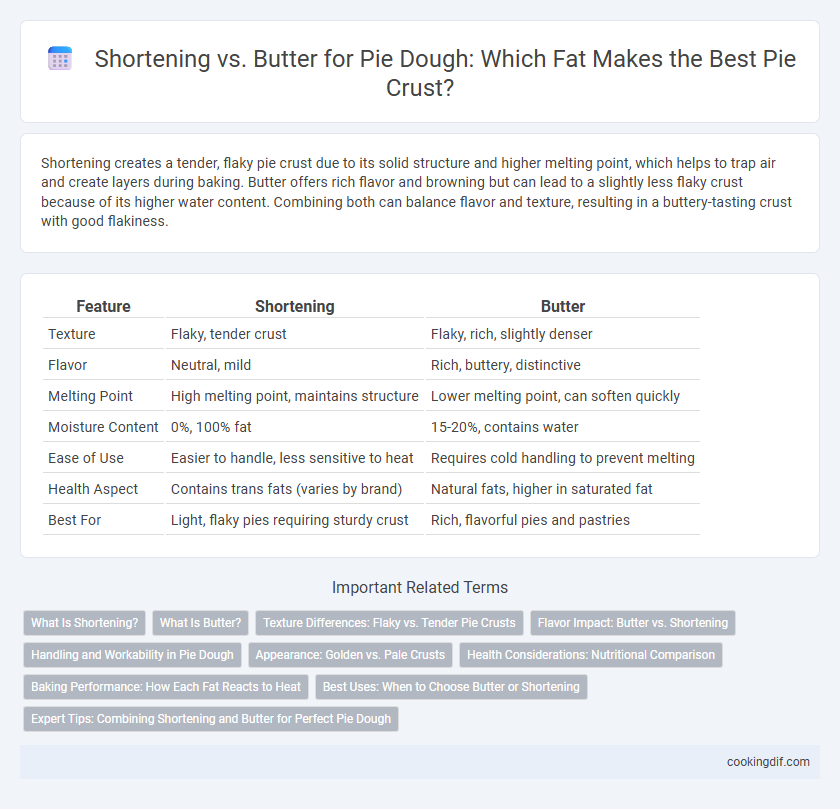Shortening creates a tender, flaky pie crust due to its solid structure and higher melting point, which helps to trap air and create layers during baking. Butter offers rich flavor and browning but can lead to a slightly less flaky crust because of its higher water content. Combining both can balance flavor and texture, resulting in a buttery-tasting crust with good flakiness.
Table of Comparison
| Feature | Shortening | Butter |
|---|---|---|
| Texture | Flaky, tender crust | Flaky, rich, slightly denser |
| Flavor | Neutral, mild | Rich, buttery, distinctive |
| Melting Point | High melting point, maintains structure | Lower melting point, can soften quickly |
| Moisture Content | 0%, 100% fat | 15-20%, contains water |
| Ease of Use | Easier to handle, less sensitive to heat | Requires cold handling to prevent melting |
| Health Aspect | Contains trans fats (varies by brand) | Natural fats, higher in saturated fat |
| Best For | Light, flaky pies requiring sturdy crust | Rich, flavorful pies and pastries |
What Is Shortening?
Shortening is a solid fat made from vegetable oils, commonly used in pie dough to create a tender, flaky texture without the water content found in butter. Unlike butter, shortening melts at a higher temperature and produces less gluten development, which helps maintain a crumbly crust. Its neutral flavor and longer shelf life make it a popular choice for pie dough that requires a consistent, buttery-flavored base without added moisture.
What Is Butter?
Butter is a dairy product made by churning cream, consisting of water, milk solids, and fat that contributes to rich flavor and flaky texture in pie dough. Its fat content is typically around 80%, which helps create tender layers as it melts during baking. The water in butter releases steam, aiding dough puffiness, while milk solids promote browning and flavor development in pies.
Texture Differences: Flaky vs. Tender Pie Crusts
Shortening produces a flakier pie crust by coating flour proteins more thoroughly, preventing gluten development and creating distinct layers. Butter yields a tender, flavorful crust with a richer texture due to its water content, which creates steam and helps dough puff during baking. Combining both fats can balance flakiness and tenderness, optimizing pie crust texture.
Flavor Impact: Butter vs. Shortening
Butter provides a rich, creamy flavor and contributes to a more aromatic and flavorful pie crust due to its milk solids and natural fats. Shortening offers a neutral taste, allowing other ingredients' flavors to stand out but lacks the depth and buttery notes found in butter-based doughs. Choosing butter enhances the overall flavor profile of the pie, while shortening focuses on texture and tenderness with less impact on taste.
Handling and Workability in Pie Dough
Shortening provides a higher melting point, resulting in a dough that is easier to handle and less sticky during rolling, enhancing workability for intricate pie crust designs. Butter, while offering superior flavor, contains more water and melts faster, which can make the dough softer and more challenging to roll out without tearing. Combining both fats balances workability and flavor, giving a manageable dough that maintains structure and a tender, flaky texture.
Appearance: Golden vs. Pale Crusts
Butter-based pie dough typically creates a golden, richly colored crust due to its milk solids caramelizing during baking, while shortening-based dough often results in a paler, more uniform crust lacking that golden hue. The higher water content and milk proteins in butter contribute to Maillard reactions, boosting the crust's visual appeal. Shortening's pure fat composition prevents browning, producing a lighter, more neutral crust appearance.
Health Considerations: Nutritional Comparison
Shortening contains no trans fats but is highly processed and rich in saturated fats, which can impact cardiovascular health if consumed excessively. Butter provides natural vitamins A and E along with beneficial fatty acids, yet it has higher levels of saturated fats and cholesterol. Choosing between shortening and butter for pie dough depends on balancing the desire for flakiness and flavor with the potential health effects of saturated fat content and processing levels.
Baking Performance: How Each Fat Reacts to Heat
Shortening melts at a higher temperature than butter, creating a flakier, more tender pie crust by maintaining distinct layers during baking. Butter offers superior flavor and browning due to its milk solids, but it melts faster, which can result in a slightly less flaky texture. The ideal pie dough balances butter's rich taste with shortening's heat stability to optimize both texture and flavor.
Best Uses: When to Choose Butter or Shortening
Butter is ideal for pie dough when a rich flavor and crisp, flaky texture are desired, making it perfect for fruit pies and tarts. Shortening excels in creating tender, crumbly crusts that hold up well under heavier fillings like custards or savory pies due to its higher melting point. For a balanced pie crust, combining butter and shortening can provide both flavor and structural stability.
Expert Tips: Combining Shortening and Butter for Perfect Pie Dough
Combining shortening and butter in pie dough enhances both texture and flavor, with shortening providing flakiness and butter imparting rich taste. Experts recommend a balance of about 50% butter and 50% shortening to achieve a tender, flaky crust that holds up well during baking. Using cold fats and minimal handling ensures optimal gluten development, resulting in a perfectly textured pie crust.
Shortening vs butter for pie dough Infographic

 cookingdif.com
cookingdif.com